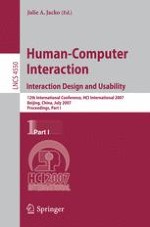The 12th International Conference on Human-Computer Interaction, HCI Inter- tional 2007, was held in Beijing, P.R. China, 22-27 July 2007, jointly with the S- posium on Human Interface (Japan) 2007, the 7th International Conference on Engineering Psychology and Cognitive Ergonomics, the 4th International Conference on Universal Access in Human-Computer Interaction, the 2nd International Conf- ence on Virtual Reality, the 2nd International Conference on Usability and Inter- tionalization, the 2nd International Conference on Online Communities and Social Computing, the 3rd International Conference on Augmented Cognition, and the 1st International Conference on Digital Human Modeling. A total of 3403 individuals from academia, research institutes, industry and g- ernmental agencies from 76 countries submitted contributions, and 1681 papers, judged to be of high scientific quality, were included in the program. These papers address the latest research and development efforts and highlight the human aspects of design and use of computing systems. The papers accepted for presentation th- oughly cover the entire field of Human-Computer Interaction, addressing major - vances in knowledge and effective use of computers in a variety of application areas. This volume, edited by Julie A. Jacko, contains papers in the thematic area of Human-Computer Interaction, addressing the following major topics: • Interaction Design: Theoretical Issues, Methods, Techniques and Practice • Usability and Evaluation Methods and Tools • Understanding Users and Contexts of Use • Models and Patterns in HCI
